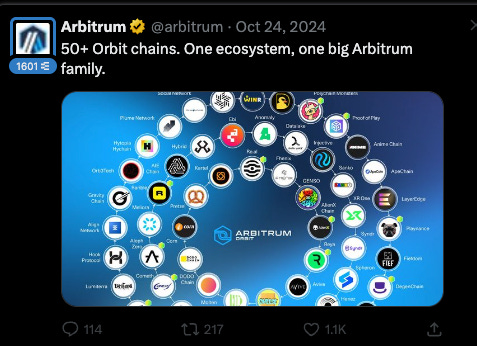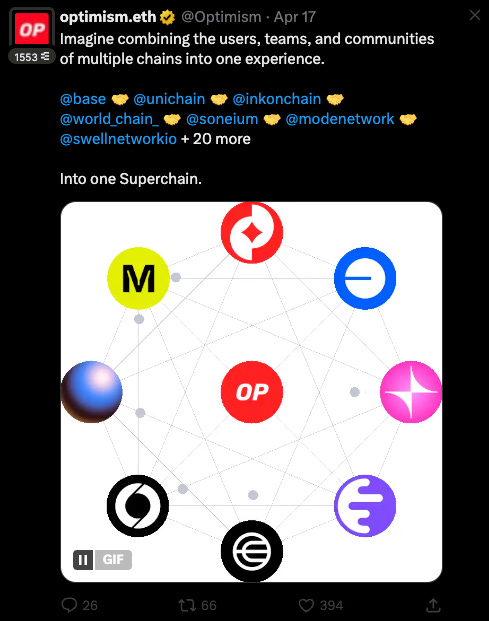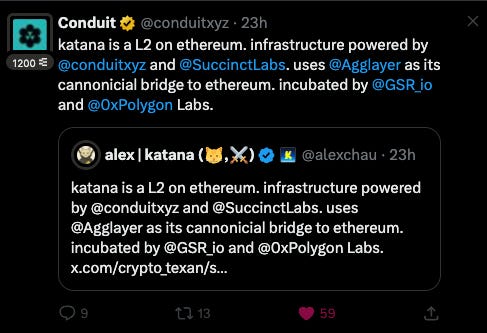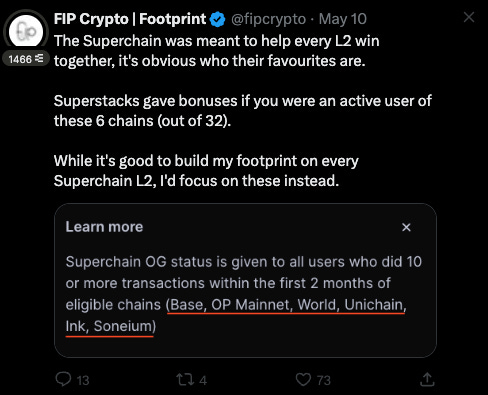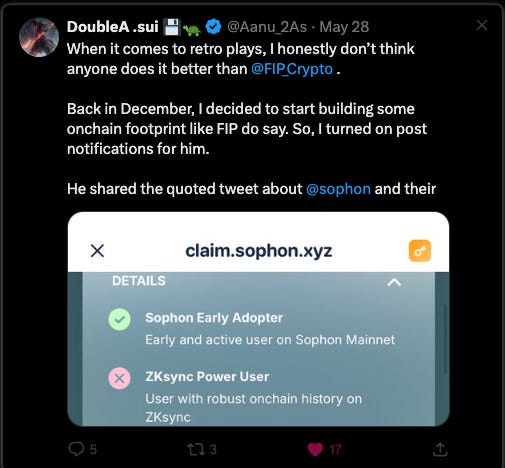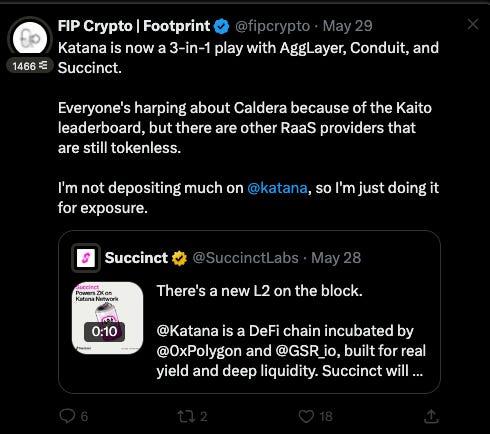The airdrop stacking opportunity you’re missing: Modular rollups
The moment I received the PYTH airdrop without even knowing it existed, something clicked:
Modular rollups are the ultimate cheat code for airdrop hunters.
They let us interact once and qualify for several rewards (through different infra projects).
Everyone hates L2s, but we’re exposed to other airdrops beyond the L2 token itself.
Just by interacting with these chains.
Here's my strategy to capture every opportunity:
Understanding modular blockchains
The first blockchains were all monolithic, where every function was carried out by the chain itself.
But these blockchains faced scaling challenges as more users came.
With more tech involved, the meta has shifted to modular blockchains.
Here’s how I think of modular blockchains in a simple way:
A single blockchain is split up into different LEGO bricks (components) and outsourced to a specific project that specialises in that task.
This graphic by @celestia sums it up well:
Every function of the blockchain can be split into a separate component (or LEGO brick).
The LEGO bricks all come together to build the blockchain, with each project responsible for 1 brick.
These are plug and play too, where any component can be added or swapped at any time.
Beyond the 4 bricks mentioned above, other modular components that form a blockchain:
Rollup as a Service (RAAs): Deploying and customizing rollups
Rollup Framework/Stack: The base architecture and tools to build and operate rollups
AltVM: Customized execution layer beyond the EVM
Proving: Generating cryptographic proofs (usually ZK)
Execution: Processing transactions
Sequencing: Ordering transactions
Data Availability (DA): Reconstructing the blockchain state with the required data
Storage: Storing and receiving historical blockchain data and states
Data Tooling: Querying, indexing, and analyzing on-chain data
Oracles: Providing off-chain data to smart contracts
Interoperability: Enabling interactions between blockchains (e.g., bridging)
Abstraction: Simplifying the experience for users interacting across different rollups
Liquidity: Ensuring availability of capital across different layers and DApps
Settlement: Finalising transactions and proofs to a Layer 1 (L1)
I took reference from @therollupco’s graphic to find a list of modular components.
It’s possible to have other components given how much the ecosystem has grown too.
Now that we understand modular blockchains better, here’s how previous infra projects conducted their airdrop:
Getting PYTH-style airdrops
The PYTH airdrop was a complete surprise for me.
I knew nothing about the project, but I still received a decent airdrop allocation.
All by interacting with projects that used Pyth’s oracles for their price feeds:
Polynomial
Synthetix
Solend
So how did Pyth decide who should get their token?
As an oracle, there’s no way for users to interact with them directly.
Instead, they would interact with DApps that use Pyth’s oracles for price feeds.
So by extension:
Using DApps that integrate Pyth’s oracles means interacting with Pyth.
And our onchain footprint helps us qualify for these drops if we’re actively interacting with these DApps.
I expect other infra projects to follow a similar distribution:
Rewarding users who interacted with their infra by using certain DApps or rollups.
So here’s my strategy to qualify for these airdrops:
The X-in-1 opportunity
Most modular infra projects are new and tokenless.
While receiving a good chunk of funding too.
By interacting with 1 rollup, we're essentially positioning ourselves for multiple airdrops (based on Pyth’s criteria).
Here's a list of tokenless projects (or those with future airdrop potential) in each component:
RaaS
@Calderaxyz
@conduitxyz
@0xZeeve
@alt_layer
@syndicateio
Rollup Framework
OP Superchain
Arbitrum Orbit
Polygon Agglayer
ZK Elastic
StarkNet’s SN Stack
Scroll SDK (lol)
AltVM
@skate_chain
@fluentxyz
@TalusNetwork
@movementlabsxyz
@N1Chain
Proving
@RiscZero (@boundless_xyz)
@lagrangedev
@nebrazkp
@SuccinctLabs
@fermah_xyz
Execution
@aztecnetwork
@EclipseFND
@initia
Sequencing/Cross-Chain
@EspressoSys
@AstriaOrg
@radius_xyz
Data Availability (DA)
@nufflelabs
@0G_labs
@Hyve_DA
@eigen_da
@celestia
@sedaprotocol
Storage
@Neova_Protocol
Data Tooling
@sedaprotocol
Oracles
@redstone_defi
@switchboardxyz
Interoperability
@hyperlane
@Polymer_Labs
@union_build
@decentxyz
@RelayProtocol
@LayerZero_Core
Abstraction
@ParticleNtwrk
Liquidity
@CatalystSystem
Settlement
@initia
Pushing transactions on rollups that integrate these components could position us for their airdrops.
And it’s possible that projects that have launched tokens to distribute additional rounds of airdrops:
AltLayer could airdrop active users of rollups deployed on their RaaS
TIA/EIGEN/AVAIL could potentially reward active users of blockchains using Celestia/EigenDA/Avail for DA
Tokenless ZK projects could airdrop to holders of ZK tokens (like what Aligned did)
This is all speculation on my end, and nothing is guaranteed.
Some of these projects mentioned above are still on testnet, so we’re still early.
By interacting with a rollup that uses all of these tokenless components for their blockchain infra:
We’re essentially qualifying for multiple airdrop opportunities.
If projects decide to follow Pyth’s criteria for airdrop distribution.
But not every rollup is a guaranteed win:
Avoid chasing every rollup
The L2 meta was crazy over the past few months, with almost every project launching a chain.
But some couldn’t take advantage of the narrative and they shut down their rollups (likely because it was too costly).
So there’s a risk that this strategy could fail too, and we need to be prepared for it.
Here are some examples:
Treasure Chain
Polygon zkEVM
Kroma
Astar zkEVM
So I would advise against chasing after every L2:
There are some (like these AI chains on Caldera) that are more consumer-facing.
So I have fewer reasons to use them.
We have to choose projects worth interacting with in the first place.
I’ll share the factors I use in another article.
So after explaining all the concepts:
Here’s the strategy I’m using to find these hidden opportunities:
How I’m positioning for infra/modularity airdrops
Every project has an ecosystem page that shares all of its integrations.
So I’d start with looking at either of these pages:
RaaS providers
Rollup frameworks
Out of the 4 main stacks, I‘d prioritise Arbitrum Orbit the least.
They seem less likely to reward active Orbit chain uses, and it seems fragmented.
As compared to the messaging for others that give me the ‘win together’ vibes, like
OP Superchain:
and Agglayer:
I’d also keep tabs on their Twitter accounts as they could share updates about new rollups.
These give me an indication of the live rollups with which I can interact.
Another alternative is going to a rollup’s ecosystem page and filtering by the 'Infra' category.
This gives me an indication of what modular infra projects they’ve integrated.
So I know how many airdrops I could potentially qualify for in one page.
With my time and capital limitations, I plan to interact with as many rollups as I can.
Especially if they run a mainnet campaign.
I’d also follow rollup news aggregators to keep up with any modular ecosystem updates, including:
@SuperchainEco
@moduverseco
I’ll share whatever I see with my Premium members on Discord.
Here are some results I’ve obtained by being active on modular rollups:
My results
Superchain (OP #5)
This was hugely attributed to Layer3, where completing multiple quests helped me qualify for OP’s 5th airdrop.
They used an Arbitrum-style criterion to reward users (likely because the eligible wallet count was low).
I would prioritise being active on the top Superchains, including:
Base
OP Mainnet
World Chain
Unichain
Ink
Soneium
Sophon (ZK Elastic)
A tokenless L2 that rewarded activity on ZKsync, I expect other ZK Elastic chains to do the same.
I’m not doing much on ZKsync, but mainly participating in governance proposals and completing certain campaigns.
Initia (LayerZero)
I didn’t get this allocation, but the top 2,000 LayerZero users received an allocation from Initia.
LayerZero has tons of integrations with different chains (some are still tokenless), so it’s worth using it for your bridging activities.
While possibly qualifying for the next LayerZero airdrop.
I first revealed this strategy in Jan 2025, and the main bulk was repurposed into this article (with minor updates)
My main focus right now is to expand my onchain footprint on these rollups:
This should position me for the next wave of airdrops (though nothing is guaranteed).
But onchain footprint alone is not enough to get the next wave of airdrops, as I shared here.
So after going through the full strategy, these are the 6 rollups that I’m focusing on:
My list of 6 best rollups to interact with right now
#1 Katana (4-in-1)
Here’s what we could be exposed to by interacting with Katana:
Katana itself (KAT drop)
Agglayer (rollup framework)
Succinct (ZK proving)
Conduit (RaaS)
Not much to do here yet except for depositing for Krates.
But I plan to be active on Katana when it’s live for more exposure.











